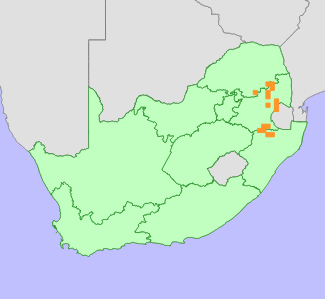|
Scientific Name | Gladiolus appendiculatus G.J.Lewis |
Higher Classification | Monocotyledons |
Family | IRIDACEAE |
Synonyms | Gladiolus appendiculatus G.J.Lewis var. longifolius G.J.Lewis |
National Status |
Status and Criteria | Least Concern |
Assessment Date | 2020/02/18 |
Assessor(s) | L. von Staden |
Justification | Gladiolus appendiculatus is a widespread species that is declining due to ongoing habitat loss and degradation. It is however not yet in danger of extinction. |
Distribution |
Endemism | Not endemic to South Africa |
Provincial distribution | KwaZulu-Natal, Limpopo, Mpumalanga |
Range | This species occurs along the eastern Drakensberg Escarpment, from Mariepskop and Pilgrims Rest in Mpumalanga, to Vryheid in northern KwaZulu-Natal. It also occurs in eSwatini (Swaziland). |
Habitat and Ecology |
Major system | Terrestrial |
Major habitats | Long Tom Pass Montane Grassland, Wakkerstroom Montane Grassland, Northern Escarpment Quartzite Sourveld, Lydenburg Thornveld, Barberton Montane Grassland, KaNgwane Montane Grassland, Northern Zululand Mistbelt Grassland, Northern Escarpment Afromontane Fynbos, Northern Escarpment Dolomite Grassland, Sekhukhune Montane Grassland, Paulpietersburg Moist Grassland |
Description | It occurs in loamy clay among dolerite rocks in grassland. |
Threats |
| About 30% of this species' habitat is already irreversibly modified, predominantly due to historical loss to commercial timber plantations. There is no longer significant expansion of plantations, but small grassland fragments among plantations are threatened by ongoing degradation due to inappropriate fire management, spreading alien invasive plants, and overgrazing by livestock. Some subpopulations are also potentially threatened by habitat loss to mining, particularly around Wakkerstroom and Barberton. |
Population |
This a widespread, but rare species, occurring as scattered plants or in very small subpopulations. Based on the extent of historical habitat loss, a population reduction of at least 30% is suspected. Habitat loss however occurred over a period longer than three generations. Recent rates of habitat loss, inferred from comparative land cover datasets, is estimated to be about 10% in 24 years. A continuing decline is inferred from ongoing habitat loss and degradation.
|
Population trend | Decreasing |
Assessment History |
Taxon assessed |
Status and Criteria |
Citation/Red List version | | Gladiolus appendiculatus G.J.Lewis | Least Concern | Raimondo et al. (2009) | | Gladiolus appendiculatus G.J.Lewis var. appendiculatus | Lower Risk - Least Concern | Scott-Shaw (1999) | | Gladiolus appendiculatus G.J.Lewis var. longifolius G.J.Lewis | Endangered | Hilton-Taylor (1996) | | Gladiolus appendiculatus G.J.Lewis | Rare | Hilton-Taylor (1996) | | Gladiolus appendiculatus G.J.Lewis var. appendiculatus | Rare | Hall et al. (1980) | | Gladiolus appendiculatus G.J.Lewis var. longifolius G.J.Lewis | Rare | Hall et al. (1980) | |
Bibliography |
Goldblatt, P. and Manning, J.C. 1998. Gladiolus in southern Africa. Fernwood Press, Vlaeberg.
Hall, A.V., De Winter, M., De Winter, B. and Van Oosterhout, S.A.M. 1980. Threatened plants of southern Africa. South African National Scienctific Programmes Report 45. CSIR, Pretoria.
Hilton-Taylor, C. 1996. Red data list of southern African plants. Strelitzia 4. South African National Botanical Institute, Pretoria.
Raimondo, D., von Staden, L., Foden, W., Victor, J.E., Helme, N.A., Turner, R.C., Kamundi, D.A. and Manyama, P.A. 2009. Red List of South African Plants. Strelitzia 25. South African National Biodiversity Institute, Pretoria.
Scott-Shaw, C.R. 1999. Rare and threatened plants of KwaZulu-Natal and neighbouring regions. KwaZulu-Natal Nature Conservation Service, Pietermaritzburg.
|
Citation |
| von Staden, L. 2020. Gladiolus appendiculatus G.J.Lewis. National Assessment: Red List of South African Plants version 2024.1. Accessed on 2025/12/12 |
 Comment on this assessment
Comment on this assessment


